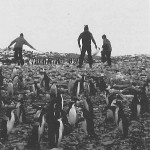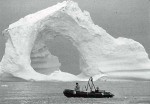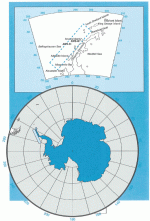The impact of sea ice on the structure and function of a pelagic marine ecosystem
By Robin Ross and Langdon Quetin
Observations to date suggest that the western Antarctic Peninsula may be especially sensitive to greenhouse-gas warming
The Palmer LTER (PAL) was established in late 1990 and focuses on the pelagic marine ecosystem west of the Antarctic Peninsula. Although the Palmer LTER is the only fully marine (from coastal to pelagic) site in the LTER Network, it shares with other sites the unifying hypothesis that physical factors control the biology of the system. The general hypothesis for PAL is that the annual advance and retreat of sea ice is a major physical factor governing the structure and function of this ecosystem, and the variability seen at all levels of the food web. A key challenge is to characterize and understand the linkages among the different spatial and temporal scales of the various physical (solar radiation, atmospheric and oceanographic circulation, and sea ice coverage) and biological components (key predators, secondary and primary consumers and microbial loop) of the Antarctic ecosystem.
The PAL study region surrounds Palmer Station (64°40’S, 64°03’W), located in a protected harbor on the southwest side of Anvers Island midway down the Antarctic Peninsula. To structure long-term regional observations, a sampling grid along the west coast of the peninsula (see figure, next page) was created which reflects the scale of atmospheric, oceanic and sea ice interactions with populations in the marine ecosystem. Within the large-scale grid are embedded smaller-scale grids encompassing the foraging ranges of the predators (seabirds) nesting near Palmer Station and where time series data can be obtained throughout the season. The following are routinely sampled within the LTER sampling grids:
- Sea ice
- In situ bio-optical water properties
- Temperature and salinity (conductivity)
- Photosynthetic pigments
- Macro-nutrient concentrations
- Phytoplankton and bacterioplankton production
- Secondary production
- Sedimentation and seabird ecology
Spatial sampling has included annual and seasonal cruises covering most portions of the large scale grid and temporal sampling has included at least weekly observations in the vicinity of Palmer Station.
Climatology
Several factors make the Palmer LTER study region ideally sited for investigations of the response of polar ecosystems to global change: a historical climate record, a strong response to climate change, a persistent pattern of sea ice and temperature anomalies, and a northern area intermittently covered and a southern area consistently covered every winter by sea ice. Although by standards in the northern hemisphere the climate record in the Antarctic is relatively short, scattered expedition records for the region west of the Antarctic Peninsula start in the early 1900s and predate the consistent, quality-controlled records of the British Antarctic Survey from the mid-1940s.
There is a statistically significant warming trend in this region over the past 45 years which is larger than elsewhere in the Antarctic. Winter temperatures show the strongest warming trend, with a 5.5°C increase in June (winter) temperatures over the 48-year record. Within the long-term record, air temperature at Faraday, a former British station only 40 km from Palmer, and the Southern Oscillation Index (501) show significant coherence. Combined with the anticorrelation between temperature and sea-ice coverage, this supports the possibility for a coherence between LTER ice extent and 501.
Since the El Nino/Southern Oscillation phenomenon is a large-scale source of climate variability, understanding this linkage is of considerable importance for the global connections of the Palmer LTER to the Southern Hemisphere. While there are complex linkages between cyclonic activity, air temperature and sea ice which have yet to be elucidated, observations to date suggest that the western Antarctic Peninsula may be an area which is especially sensitive to greenhouse-gas warming.
In the Palmer LTER region, both air temperature and sea-ice extent show persistent anomalies which appear as consecutive high ice/low temperature years followed by consecutive low ice/high temperature years. These anomalies appear to impact the survival rates, distributions and life histories of a number of dominant species in the pelagic marine ecosystem. High interannual variability in these physical factors provides a study site where “natural” experiments will test the sensitivity of ecological processes to climate variability and change.
Highlights from Recent Research
The interaction between the Adélie penguin and its primary prey, Antarctic krill, provides an example of research across variable space/time scales associated with the Palmer LTER. During the past three summers, we have conducted investigations (making use of both ship and shore based observations) during a critical period of chick rearing of the relationship between prey availability and penguin at-sea foraging behavior, and the reproductive ecology of the Adélies nesting in the nearby rookeries. During this critical period, prey biomass has varied by more than an order of magnitude, with parallel changes in foraging duration and adult behavior necessary to feed the chick(s). Two interactive possibilities exist to explain this variability in krill availability, variability in recruitment leading to decreases in the stock, and/or shifts in population distributions linked to changes in atmospheric and oceanic circulation. Factors that affect the population dynamics and distribution of krill populations on the mesoscale and over its seven-year life span affect prey availability on small time (critical period during chick rearing) and space (foraging range) scales for the Adélies. Prey availability in turn impacts reproductive success in the Adélies that season. Krill recruitment success has been highly variable in the Palmer LTER regions, and is strongly correlated with the timing and magnitude of winter ice, a physical factor operating on regional scales.
Primary production and phytoplankton standing stock also vary on several time and space scales. Temporal observations in the nearshore Palmer grid over the production season and spatial observations in the larger regional grid during a restricted period show strong seasonal and interannual variability. The two seasons following winters with high ice coverage developed overall phytoplankton biomass during bloom periods five times greater than two other seasons, on both the fine- and regional scale grids. On/offshore gradients were present in all years, and there is evidence that this gradient is modulated alongshore by latitudinal variability and the annual advance and retreat of sea ice.
Results from the first four field seasons support the hypothesis that interannual variability in physical factors such as sea ice impact all levels of the ecosystem and that this provides the Palmer LTER with the means to investigate the impact of these physical factors on the structure and function of the pelagic marine ecosystem.
For more information see the PAL web site at http://www.icess.ucsb.edu/lter or contact members of the Palmer LTER:
- Karen Baker, karen@icess.ucsb.edu
- Bill Fraser, ubiwf@trex.oscs.montana.edu
- Eileen Hofmann, hofmann@kuroshio.ccpo.odu.edu
- Dave Karl, dkarl@iniki.soest.hawaii.edu
- John Klinck, k/inck@kuroshio.ccpo.odu.edu
- Langdon Quetin, langdon@icess.ucsb.edu
- Robin Ross, robin@icess.ucsb.edu
- Ray Smith, ray@icess.ucsb.edu
- Wayne Trivelpiece, ubiuit@msu.oscs.montana.edu
- Maria Vernet, mvernet@ucsd.edu

 Enlarge this image
Enlarge this image

